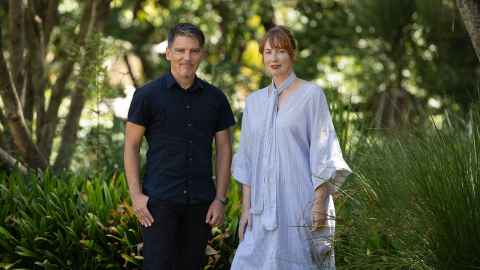Shedding new light on New Zealand's first photographs
28 May 2024
Shaun Higgins and Catherine Hammond's new book digs into the origins of photography in Aotearoa. They talk with Megan Fowlie about what they uncovered.

Photography arrived in Aotearoa in the early decades of colonisation, recording and manipulating moments of place and time.
Shaun Higgins and Catherine Hammond, both University alumni, have sleuthed their way through the image collections of Auckland War Memorial Museum, Alexander Turnbull Library and the Hocken Collections to answer who first engaged with the camera here, and when and why.
They explore, for example, what a glass plate negative can tell us, or why you would sit for up to 45 seconds for an early daguerreotype.
Here the editors of A Different Light: First Photographs of Aotearoa, which digs into such territory, talk with Megan Fowlie about the book, and what it uncovers.
What was the spark that led to this book?
The inspiration for A Different Light germinated in a conversation at the close of another photography exhibition, Being Chinese in Aotearoa, discussing early photographs, seldom displayed and with multiple perspectives.
What big question did you set out to answer?
We set out to experience early photography in Aotearoa: what it looked like, its wonder and meaning. Rather than the story of individual photographers, our focus became closely tied to its social impact, the photograph as a tool of colonisation and the complex impact for Māori, examining how we can look past one narrative and see another.
What do these photos tell us about ourselves?
While it was a time when we were encouraged to say ‘prunes’ rather than ‘cheese’ – to be serious and still – many aspects of photography are the same today: a desire to alter our image beyond how we appear, and to document our lives. These images tell us about human interaction with technology – the rapid global rise of photography, its democratisation, its use, and misuse – that has many parallels today.
As time progresses, our own perspectives shift, and we
can continually look back with new questions.
What did you find most satisfying in creating this publication?
Working across the three enormous collections. Together, they hold around 10 million photos. Even for the 19th century, we had many thousands of potential images to show. Then, exploring them in more detail during conservation preparation for imaging and display let us look behind the cases, see the plates inside and further try to solve some of the mysteries around their creation.
Why document this?
As we proceed through the digital 21st century, we look back on collections from the past and how we might revisit them. Memory institutions keep safe these moments, but as time progresses, our own perspectives shift, and we can continually look back with new questions.
What do you find most tantalising about the collections and the images you accessed?
The bursts of colour from a time of largely monochrome imagery. We call it black and white, but it is shades of brown, sepia, even cyan, and then all the brass, gold and velvet that accompanies them in cases and frames. The photographs themselves hold, more than visible at first glance, people, not necessarily miserable, but simply sitting for a long time in a Victorian setting. They are complemented by the burst of colour that challenges our perception of the black and white age.
How are we misled by photographs – and does A Different Light aim to set the record straight?
Since the beginning, photographs have been manipulated – from the moment someone chooses what to place in the frame, to retouching the image, to creating new montages. The book shows some of these examples and allows the reader to think about what is real and what is false. Does the camera lie?
Shaun Higgins and Catherine Hammond work at Tāmaki Paenga Hira Auckland War Memorial Museum, where Shaun is pictorial curator and Catherine is director of collections and research.
This article first appeared in the Autumn 2024 edition of Ingenio.